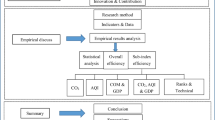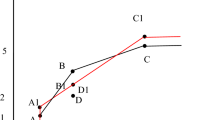Abstract
It is important to evaluate the impact of undesirable energy output on the climate-carrying capacity of the power grid-based economy to promote the green development. Three indicators—climate natural capacity, urban climate pressure, and urban coordinated development capacity—are used as input factors to study the climate-carrying capacity. The Nemerow index method and comprehensive evaluation method based on entropy weight are employed to calculate inputs. Pollution emissions such as carbon dioxide emissions, waste gas, wastewater, and solid waste pollution are included as energy undesirable outputs, and industry output value is included as a desirable output to calculate the non-radial directional distance of the output of climate-carrying capacity that combines desirable and undesirable outputs. The total factor non-radial directional distance function and energy-environmental non-radial directional distance function are used to obtain the efficiency index of total factor climate-carrying capacity and the efficiency of climate-carrying capacity performance, respectively. These two indices are included in the analysis to estimate the impact of energy undesirable output on climate-carrying capacity. Results from empirical analysis showed that when two types of undesirable outputs, namely waste gas and wastewater outputs, in Shanghai are constrained, the efficiency and performance efficiency of climate environmental carrying capacity are both lower than 0.8, indicating that undesirable outputs had a substantial influence on the climate-carrying capacity. In Shanghai, the major approach to improve the regional climate-carrying capacity is to improve energy efficiency and reduce undesirable outputs of power grid-based economy.

Similar content being viewed by others

Data availability
The datasets generated and/or analyzed during the current study are available in the China’s Environmental Yearbook, the China Statistical Yearbook, and the China Energy Statistics Yearbook repository, which are all available at http://www.stats.gov.cn.
References
Ge S, Zhang R, Yang M (2017) Natural environmental risk assessment of northwest passage in the context of climate change. Mar Sci Bull 36(2):121–127 (In Chinese)
Guyondet T, Comeau LA, Bacher C, Grant J, Rosland R, Sonier R, Filgueira R (2015) Climate change influences carrying capacity in a coastal embayment dedicated to shellfish aquaculture. Estuar Coasts 38(5):1593–1618
Hai-**g LI (2007) Research progress on the methods of the atmospheric environmental capacity calculation and total quantity control. Sichuan Environ 20(1):67–71 (In Chinese)
Hallegatte S, Corfee-Morlot J (2011) Understanding climate change impacts, vulnerability and adaptation at city scale: an introduction. Clim Chang 104(1):1–12
IPCC (2014) Synthesis Report. Contribution of working groups I. II and III to the Fifth Assessment Report of the Intergovernmental Panel on Climate Change, 151(10.1017)
Jiang L, Probst TM (2015) A multilevel examination of affective job insecurity climate on safety outcomes. J Occup Health Psychol 21(3):366–377
Jiang R, Zeng R, Li H (2016) Multi-objective optimization and evaluation of distributed CCHP system considering climatic conditions and building types. Proc CSEE 36(12):3206–3213 (In Chinese)
Kalnay E, Cai M (2003) Impact of urbanization and land-use change on climate. Nature 423(6939):528–531
Karl TR, Trenberth KE (2003) Modern global climate change. Science 302(5651):1719–1723
Lu J (2018) Analysis of dynamic carrying capacity of water resources in Tieling city. Technol Soil No.182(02):16–17 (In Chinese)
Pan J, Zheng Y, Wang J, **e X (2014) Climate capacity: a measure of adaptation to climate change. Chin Popul Resour Environ 24(2):1–8
Qian X (2016) G20 from the perspective of global energy and climate governance. Teach Res V50(10):71–78 (In Chinese)
Rosenzweig C, Solecki WD, Hammer SA, Mehrotra, S. (Eds.). (2011) Climate change and cities: first assessment report of the urban climate change research network. Cambridge University Press
Sharkey MJ (1970) The carrying capacity of natural and improved land in different climatic zones. Mammalia 34(4):564–572
Shen L, Shu T, Liao X, Yang N, Ren Y, Zhu M, Wang J (2020) A new method to evaluate urban resources environment carrying capacity from the load-and-carrier perspective. Resources Conservation and Recycling 154:104616
Shengjun Y, Xuan W, Weihua Z, Guannan C (2017) Quantitative assessment of climate carrying capacity for cities: a case study of Shanghai City. J Resour Ecol 8(2):196–204
Shili QGZYW (2001) The Impacts of climate change on the interlock area of farming-pastoral region and its climatic potential productivity in Northern China. Arid Zone Res 1:23–28 (In Chinese)
Wang Y, Zhou B, Reng Y (2016) Reflection on the impact of global climate change on China's climate security. J Appl Meteorol Sci 27(6):750–758 (In Chinese)
Wen L (2018) Evaluation of resource and environment carrying capacity and diagnosis of obstacle factors in Jiangsu province based on abrupt progression method. Res Soil 25(3):354–359 (In Chinese)
Wu X, Lai G, Wang H (2018) Evaluation of climate carrying capacity in Nanchang city. Jiangxi Sci 36(4):615–618
**ong M, Li M, Li J (2017) Impact of climate change on typical meteorological year data and energy consumption assessment -- a case study of Tian**, a large city in northern China. Adv Clim Chang Res 13(5):494–501 (In Chinese)
Xu X, Cai G, Hao F (2016) Analysis on the utilization status and carrying capacity of water resources in energy base -- taking Shanxi Province as an example. Environ Pollut Prev 38(6):69–74 (In Chinese)
Yu L, Yu YY, Huang W (2015) Significance and basic methods of climate carrying capacity assessment. Climate Change Report (in Chinese), 268–280
Yuan B, Guo J, Ye M, Zhao J (2012) Variety distribution pattern and climatic potential productivity of spring maize in Northeast China under climate change. Chin Sci Bull 57(26):3497–3508
Yue X, Yu L, Huang M (2017) Preliminary assessment of climate carrying capacity of Bei**g area under the influence of human activities. Adv Clim Chang Res 13(6):517–525
Zhang H, Qi T, Zhang D (2015) Research hotspots and major trends in the field of energy and climate change. Renew Energy Sources (In Chinese) 33(8):1214–1218
Zheng J, Yu H, Huang S (2017) Study on ecological environment carrying capacity evaluation and obstacle factors in Fujian province based on DPSIR-TOPSIS model. J Environ Sci(In Chinese) 37(11):4391–4398
Zheng K, Yun Y, Chang W (2018) Research on “climate bearing - spatial adaptation” method of coastal cities -- **amen climate bearing space simulation analysis. Urban Stud (In Chinese) 25(8):57–64+88
Zhu R, Shi W, Wang Y (2018) Suggestions on ecological and climatic effects of wind power development and utilization in China. Chin Eng Sci (In Chinese) 20(03):47–51
Zou H, Hu G, Shan Q (2018) Analysis of impacts of climate change and human activities on runoff changes in **angjiang river basin. Water Resour Power(In Chinese) 36(9):34–38
Acknowledgments
This paper would like to thank YourS (Shanghai) Education for its translation and proofreading services.
Funding
This study was not supported by any funding.
Author information
Authors and Affiliations
Contributions
WS collected data from various databases and analyzed data by setting corresponding models. FS is mainly responsible for writing the whole paper and supervises the whole research.
Corresponding author
Ethics declarations
Conflict of interest
The authors declare that they have no conflict of interest.
Ethical approval and consent to participate
Not applicable.
Consent for publication
Not applicable.
Additional information
Responsible editor: Eyup Dogan
Publisher’s note
Springer Nature remains neutral with regard to jurisdictional claims in published maps and institutional affiliations.
Rights and permissions
About this article
Cite this article
Shan, W., Wang, F. An impact assessment of energy undesirable output on climate-carrying capacity: a case study of Shanghai. Environ Sci Pollut Res 28, 40126–40136 (2021). https://doi.org/10.1007/s11356-020-10936-4
Received:
Accepted:
Published:
Issue Date:
DOI: https://doi.org/10.1007/s11356-020-10936-4



